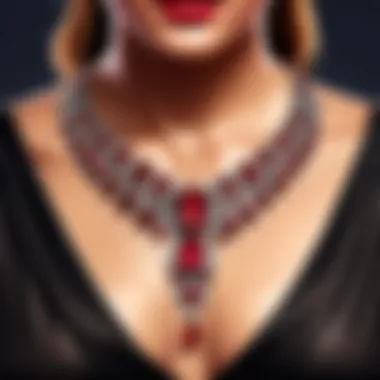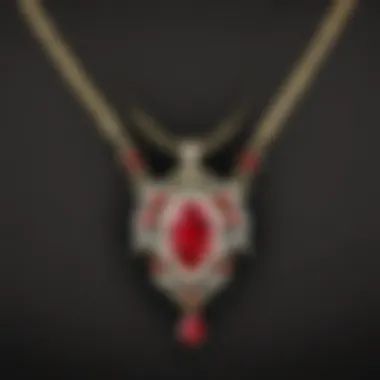Evaluating the Worth of Ruby Necklaces: Key Factors


Intro
In understanding the worth of ruby necklaces, one must consider a tapestry of factors that converge to determine their value. The criteria for valuation weave through aspects like the quality of the rubies used, the artistry of the craftsmanship, prevailing market dynamics, and established standards for valuation. Each of these factors influences not only the monetary price but also the desirability among collectors and enthusiasts. This article seeks to illuminate these essential elements, culminating in a deeper comprehension of what drives ruby necklace valuations in both the jewelry market and collector communities.
The Quality of Rubies
The quality of a ruby is paramount in valuation. Essential characteristics hinge on four main criteria often referred to as the
Foreword to Ruby Necklaces
Ruby necklaces possess an allure that draws both casual admirers and serious collectors. The vibrancy of rubies, derived from their deep red color, symbolizes passion and vitality. This section discusses the significance of ruby necklaces and sets the stage for understanding their valuation.
The importance of ruby necklaces lies in several factors that intertwine to enhance both aesthetic appeal and intrinsic value. Firstly, the quality of each ruby is paramount. Factors such as color, clarity, cut, and carat weight—collectively known as the Four Cs—serve as benchmarks for evaluation.
Additionally, craftsmanship influences the overall worth. The design and setting can dramatically affect a necklace's desirability. A poorly crafted setting, regardless of stone quality, can diminish the allure of even the most exquisite rubies. Thus, understanding what constitutes respectable craftsmanship is essential.
Moreover, the market context cannot be overlooked. Ruby necklaces fluctuate in worth based on economic conditions and collector interest. This makes knowledge of market trends equally important. For potential buyers or investors, knowing these details can guide practical choices.
“A well-rounded understanding allows buyers to make informed decisions, ensuring both satisfaction and monetary value.”
Understanding Rubies
The importance of this topic also extends into the realm of enthusiasts and collectors. As the fascination with colored gemstones increases, expertise in ruby identification and valuation becomes essential not only for buyers but also for sellers and appraisers alike.
Several considerations surround understanding rubies:
- Value Influencers: A deeper comprehension of the qualities that affect a ruby’s price, such as its origin and treatment, prepares buyers for informed purchasing.
- Sustainability: Knowledge about ethical sourcing and environmental impact is evidently crucial for modern consumers who value sustainability in their jewelry choices.
- Authenticity Confirmation: In today’s age, where synthetic rubies exist, being able to tell genuine rubies from artificial ones can be a valuable skill.
This broad base of knowledge sets the stage where one can practically assess and appreciate ruby necklaces, transcending mere aesthetics.
What Are Rubies?
Rubies are a precious variety of the mineral corundum. They are formed under high pressure and temperature conditions in the Earth's crust, enriched with chromium, which gives them their vivid red color. This reddity ranges from pink to deep blood-red, making rubies widely sought after.
In terms of their chemical composition,
- Corundum (Al2O3) gives rubies their hardness. This is rated 9 on the Mohs scale, allowing rubies to resist scratches better than other gemstones.
- Their bright color makes them stand out in the world of gemstones.
From an historical Gonzalez perspective, rubies have been symbols of power and love. Ancient warriors wore them for protection in battle, and they are often mentioned in literature and folklore.
The Geological Formation of Rubies
Rubies form in metamorphosed limestone and dolomite where aluminum oxides interact with chromium and other trace elements. This occurs deep in the Earth’s crust under heat and pressure over millions of years.
The specific geological conditions required to create rubies lead to several distinct types:


- Natural rubies are formed in nature without human interference.
- Synthetic rubies are made in labs using techniques like the Verneuil process, aiming to mimic the characteristics of natural rubies.
- Treated rubies may undergo processes to improve color and clarity.
Location also plays a role in their formation and subsequent value. Rubies from Burma (Myanmar), for instance, hold a premium, establishing a lineage for fine quality. Understanding the geological formation of rubies reveals lot's about their uniqueness.
Types of Rubies
Rubies can be classified mainly into these categories:
- Natural: Formed naturally in the earth, these stones are considered more valuable, especially if found in reputed deposits.
- Synthetic: Lab-created stones that can be chemically identical to natural rubies. While they can look the same, these typically hold a much lower value in the stone market.
- Heat-Enhanced: This method improves color and clarity. Most rubies undergo this treatment, which raises their desirability but also impacts value based on treatment disclosure.
- Star Rubies: These are unique due to their asterism, where the light reflects, creating a star-like pattern. The star effect appears due to rutile inclusions in the stone during growth, making them particularly striking.
The classification offers insight into valuation factors and market demand where natural feature captures a premium on price.
“The more you understand the nuanced types of rubies, the better positioned you are to assess their worth in the jewelry market.”
The essence of understanding rubies extends beyond physical attributes, covering historical and symbolic significance too. By grasping their facets, potential buyers can navigate the complexities of ruby necklace valuation with confidence.
Identifying Quality Factors of Rubies
Examining the quality factors of rubies is essential when assessing ruby necklaces. These factors influence both the beauty and the overall value of the gemstones. Recognizing these aspects allows potential buyers or collectors to make informed decisions. Consequently, understanding the quality of rubies serves as a solid foundation for discussions about ruby necklaces.
Color
Color is widely regarded as one of the most significant quality factors for rubies. The best rubies exhibit a vivid, intense red color, often referred to as 'pigeon blood' red. Such specimens are rare and command higher prices. However, not every ruby exhibits the ideal hue. Factors such as lighting and surroundings can influence perceived color. When evaluating color, consider the following aspects:
- Hue: True red is highly prized, but orange or purple undertones can decrease value.
- Saturation: Strong saturation with an absence of color zoning delivers value. Zoning refers to visible differences in color within the stone.
- Tone: The ideal ruby maintains an overall medium to medium-dark tone, avoiding both overly dark or excessively light appearances.
Clarity
Clarity involves assessing the presence of inclusions and blemishes within a ruby. The clearer the stone, the higher its value. Many rubies contains inclusion patterns, known as ‘silk’, which, depending on their visibility, can improve certain characteristics, such as the luminosity of the stone. Key notes about clarity include:
- Inclusions: Evaluating the type, size, and number of inclusions is essential.
- Blemishes: Identifying surface imperfections also matters, though they have less impact compared to internal inclusions.
- Eye-clean appearance: Rubies that appear clear to the unaided eye tend to have a higher market appeal.
Cut
The cut of a ruby holds significant importance in its overall brilliance and visual appeal. A well-cut ruby allows for optimal light reflection and refraction. This increases the stone's sparkle, contributing to desirability. The aspects associated with ruby cuts include:
- Carat Shape: The most common shapes are oval, round, cushion, and pear. Each shape offers unique aesthetics.
- Proportions: Precision in ratio influences how light travels through the stone, thus affecting its brilliance.
- Polish: Examining for marks resulting from bad polishing will also inform assessments.
Carat Weight
Carat weight measures the size of a ruby with each carat equating to 200 milligrams. While larger rubies are often more valuable, other factors contribute as well. Thus, a small, high-quality ruby may indeed be worth more than a larger, lower-quality stone. Key considerations include:
- Rarity of Size: Larger, high-quality rubies are considerably rare, driving prices up.
- Proportional Beauty: Sometimes, composition matters more than size in establishing value.
Ultimately, grasping these quality factors offers better insight into ruby valuation. Buyers should weigh each characteristic carefully for a holistic viewpoint, ensuring their purchase represents both aesthetic pleasure and prospective value gain.
Necklace Design and Craftsmanship


Understanding the design and craftsmanship of a ruby necklace plays a crucial role in determining its value. These elements go beyond aesthetics. They influence the overall quality and appeal of the piece, driving both market prices and collector demand.
Types of Necklace Settings
The setting of a ruby necklace significantly affects its appearance and function. The common types of settings include prong, bezel, and pavé.
- Prong Setting: This setting uses small metal claws to hold the ruby in place, showcasing its color and brilliance. It allows light to penetrate the gemstone from different angles.
- Bezel Setting: In this type, metal surrounds the gemstone completely, offering a robust safeguard for the ruby. This design typically emphasizes durability over brilliance.
- Pavé Setting: Extremely scenic, pavé settings include many small stones set closely together, usually with tiny prongs to minimize visibility. This creates a sparkling effect that dazzles.
A thoughtful choice of setting elevates the perceived worth of the necklace by affecting how light interacts with the rubies, enhancing the jeweller's artistry and intent.
Materials Used in Necklace Creation
The choice of materials plays a fundamental role in the final product. The metal utilized and its quality can dictate the durability and finish of the piece. Common materials include gold, platinum, and silver.
- Gold: Often favored for its luminance and status, gold necklaces can come in various karats. Higher karats indicate higher purity.
- Platinum: Renowned for its strength and rarity, this material provides a unique allure, often elevating the value of the necklace significantly.
- Silver: Though more affordable, silver must be tempered and maintained appropriately to avoid tarnishing. It allows wider access to ruby jewelry without significant investment.
The combination of these materials in a necklace reveals the jeweler's mastery. Each contribution to the design counts for longevity and beauty, thereby affecting evaluation.
Importance of Craftsmanship
Craftsmanship relates closely to the quality and precision with which petty designs are brought to life. Effective craftsmanship ensures that every facet of the necklace - from the setting of the ruby to the quality of finished links - enhances durability and appeal.
Good craftsmanship can:
- Ensure the security of rubies, minimizing chances of loss or damage.
- Enhance the overall aesthetic, making the piece more desirable.
- Merge contemporary techniques with traditional artistry, showing versatility in designs.
The viewer becomes acutely aware of the fine distinctions between inferior and superior craftsmanship over time. This attention to detail signifies higher worth, appealing to discerning buyers.
Market Trends in Ruby Valuation
Current Demand for Rubies
The current demand for rubies fluctuates based on market conditions, cultural interests, and individual tastes. Generally, these gemstones experience heightened interest during certain periods. Their popularity often correlates to their availability and market presence. Factors like economic conditions and consumer preferences play a significant role in the current market.
When buyers are optimistic about the economy, the demand for luxury items, such as ruby necklaces, frequently increases. Conversely, periods of economic downturn can reduce purchases.
Cryptocurrency growth and social media influence also drive demand more in unique ways yet. Social platforms often showcase ruby necklaces, resulting in spikes of interest among younger demographics. Additionally, prominent publications may celebrate the returns of fine jewelry, impacting overall ruby fascination.
Historical Price Trends
Historical price trends provide insight into the valuation of rubies over time. Historically, the price of rubies has seen long-term increases. Some gems from locations like Myanmar or Thailand have achieved remarkable price points over decades. This long-term appreciation is attributable to both rarity and desirability.
Significant events, like auctions of historic jewels, also shift price trends considerably. In 2015, for instance, a spectacular ruby pendant outsold expectations, making headlines. This exceptional sale led to renewed resources, elevating ruby costs substantially in the years immediately following.
Tracing the patterns of price movement in ruby valuation can highlight promising investment timings as well. Understanding these movements is not just about investing wisely. It's to be aware of what to expect when engaging with collectibles like these.
Cultural Significance of Rubies


The cultural significance of rubies adds to their market place appeal. Antiquity imbues rubies with stories and traditions. Many cultures attribute various meanings to the ruby gemstones. The association of rubies with love, passion, and power grants them not only aesthetic value but also emotional depth.
In some traditions, rubies are thought to grant protection and bring good luck to their wearers. These beliefs amplify the intrinsic worth of ruby necklaces in markets and personal networks. This ties together admiration for their visual beauty with added cultural narratives that resonate deeply with many buyers.
Surprisingly, trending worldwide events often reassess the importance of reputation that rubies carry. Celebrities adorned with rubies at significant events can awaken public interest, magnifying fanaticism surrounding ruby necklaces. Overall, both cultural attachments and market reflections play a vital role in understanding the valuation of ruby earrings or necklaces.
The relationship between cultural significance and valuation is complex yet significant, informing how collectors and investors position their ruby acquisitions.
Professional Appraisal of Ruby Necklaces
A professional appraisal serves multiple important objectives. First, it acts as an objective measure of worth, which is particularly valuable during buying or selling processes. Without an expert evaluation, individuals might underestimate or overestimate the value of their jewelry. Second, appraisals can aid in establishing proper insurance coverage. Should a necklace be lost, damaged, or stolen, reliable valuation can ensure the holder can claim appropriate compensation.
Lastly, an appraisal allows for a fair market perspective, creating transparency for collectors and investors. This unbiased viewpoint can lead to more informed decisions about purchases or sales. Therefore, understanding how appraisal standards operate and selecting a qualified appraiser becomes vital for anyone interested in the prospect of ruby necklaces.
Understanding Appraisal Standards
When considering the professional appraisal of ruby necklaces, it is essential to grasp what appraisal standards entail. These standards can vary slightly among appraisers but generally adhere to established guidelines regarding quality assessments.
Each gemologist or jewelry appraiser employs certain criteria to determine the value, usually based on the
The Role of Certification in Ruby Valuation
Importance of Gemstone Certification
Gemstone certification serves several essential functions in the realm of jewelry valuation, especially with rubies.
- Verification of Authenticity: Certification proves that the ruby is genuine and not a synthetic imitation. Lab-made rubies can sometimes appear similar but have different quality rankings. Authentic gemstones tend to garner higher value in the market.
- Quality Assessment: Certification institutions evaluate rubies based on specific criteria including color, clarity, cut, and carat weight. This information helps potential buyers make informed decisions. A detailed certificate can provide distinguishing features not always visible to the naked eye.
- Investment Confidence: For collectors and investors, certified rubies can be seen as a safer investment. A gemstone’s certification indicates that it holds a recognized rank in the scale of value which reduces perceived risks related to the purchase.
- Market Stability: Gemstones with reliable certifications often have more competitive pricing and clear benchmarks. As different sources present gemstone prices, certificates help standardize what one can expect to pay for a quality ruby necklace.
Above all, obtaining a certification before purchasing an expensive ruby necklace can save buyers from expensive pitfalls.
Reputable Certification Organizations
When shopping for certifications, buyers need to rely on a few reputable organizations to ensure they are receiving actual assessments of the gemstones. The following organizations are recognized authority in the gemstone certification realm:
- Gemological Institute of America (GIA): GIA sets the standard for high-quality gem certification. Their reports provide comprehensive details on rubies, assessing each gemstone based on specialized criteria.
- American Gem Society (AGS): AGS is renowned for emphasizing ethical practices along with quality assessments. They ensure their evaluations promote truthful information to consumers.
- International Gemological Institute (IGI): IGI offers globally recognized evaluation services. Their reports not only include basic details but also provide a status on enhancements that a ruby may have undergone.
- European Gemological Laboratory (EGL): While EGL has various branches, it is notable for evaluating stones with high standards of expertise.*
In closing, choosing a certified ruby necklace goes beyond just aesthetics; it's an essential consideration that influences its value assurance and authenticity. It helps buyers navigate the often-complicated world of jewelry weighting with clarity.
Epilogue: Understanding Ruby Necklace Worth
In summarizing the worth of ruby necklaces, it is vital to recognize the myriad factors contributing to their value. Understanding aspects such as ruby quality, craftsmanship, and current market trends equips potential buyers, collectors, and enthusiasts with essential insights. This knowledge can profoundly affect investment decisions and personal purchases.
The quality of the rubies, assessed through criteria like color, clarity, cut, and carat weight, directly correlates with their appeal. Consistently, high-quality rubies command premium prices. Thus, when evaluating a ruby necklace, one should meticulously examine these attributes.
Additionally, the craftsmanship of the necklace itself plays a crucial role. An exceptional design can elevate the perceived value beyond the raw materials alone. Recognizing well-executed settings or innovative craftsmanship can make a keen difference, influencing both retail and collector markets.
Market trends further dictate the conditions under which these pieces are bought and sold. Observing changes in demand and how they spike during certain periods—such as anniversaries or cultural celebrations—extends into the strategic evaluation of worth.
Furthermore, acquiring certified pieces ensures authenticity and enhances desirability. Knowledge of reputable certification organizations helps safeguard investors from potential pitfalls in the gem market.
Overall, synthesizing these elements fosters a comprehensive understanding of what defines ruby necklace worth. Making informed choices, backed by robust information empowers buyers in a dynamic market. A well-informed purchase can lead to enduring satisfaction and add significant value over time.
"Invest in knowing the details. The intricacies you discover may turn what seems like a luxury into a worthwhile investment."



